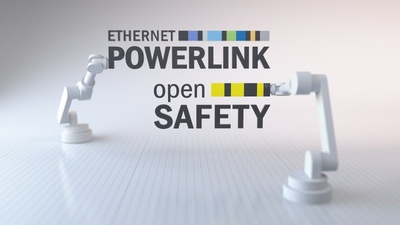
Contact Details:
KlareTech
Unit 7B Five Star Junction, Juice street, Honeydew
Johannesburg
Gauteng
2170
South Africa
Tel: +27 11 7949684
Send Enquiry | Company Information

How to talk to robots
Product News Friday, August 14, 2015: KlareTech
Industrial robots are becoming an increasingly common feature of modern production lines. During both initial setup and normal operation, they need to work safely in close proximity with human operators. The choice of a communication protocol plays a decisive role in making this possible. POWERLINK and openSAFETY have established themselves as the perfect backbone for applications involving robotics.
Robots are taking on a growing range of responsibilities for tasks that are too difficult or dangerous for humans, such as lifting heavy loads or feeding workpieces into a milling machine. When it comes to solutions that involve robots, there are always three main requirements that must be kept in mind:
Precise and responsive motion control
A powerful controller
High-speed internal communication
Mastering complex robotic systems
At the same time, machines whose automation includes robots frequently have other axes with which the robotic movements must be synchronized. One such scenario could involve a robotic arm that needs a different tool to complete the processing of a workpiece, for example. To do this, the arm moves linearly along an axis to the tool magazine, picks up the new tool and then moves back to its original position.
Not only is tight axis synchronization essential to the machine's precision, it also increases the speed of the system as a whole. Here, too, the common practice has been to use proprietary solutions, with the result that robots and other axes rely on two separate control systems. "Establishing uniform communication across the entire line is virtually impossible with this approach," explains Schönegger. "And until now, users have been stuck with the consequences: impeded system performance and more expensive, time-consuming commissioning and maintenance."POWERLINK delivers its fast response times even over large networks with heavy traffic. As a real-time communication standard, it transmits data in individual telegrams that arrive directly at the receiver without delay. Its cross-communication capabilities also make it possible for intelligent field devices to bypass the network master and exchange data directly, allowing robots to directly share data among themselves as well as with other machine axes, for example. This is one of the clear advantages behind POWERLINK technology.
With multiplexing, data can be transmitted exactly when it is needed. This allows time-critical nodes to be handled in every network cycle, while data from non-time-critical nodes is transmitted in every nth cycle. The foil stretching machine from Brückner, for example, demands absolute synchronization of its 728 axes, which receive their position values precisely every 400 µs. At the same time, non-time-critical temperature control plays an important role in product quality.
POWERLINK also offers users complete network design freedom – supporting star, bus and ring topologies or any combination thereof. The open protocol allows failsafe networks to be implemented with line and master redundancy without requiring any special hardware. This ensures that operation is not affected by network connectivity problems. These features give machine builders free reign during conceptual design, allow robotic systems to be integrated anywhere they are needed and guarantee maximum availability.
Free selection of hardware manufacturer
Today's solutions need a real-time Ethernet protocol that provides high-speed data transfer as well as openness. That's why more and more robotics users are choosing POWERLINK. Available as an open source stack at www.sourceforge.net, this software-based protocol helps companies avoid dependence on specific hardware manufacturers. POWERLINK also complies with the recognized IEEE 802.3 Ethernet standard and offers hard real-time capabilities.
Another key requirement of a communication protocol is reliable synchronization of all axes. "While there are a number of industrial Ethernet systems that have the necessary bandwidth, in some cases the transfer rate drops dramatically as you add axes," says Schönegger.
Systemwide safety for production lines
If you want the flexibility to do away with safety gates in order to place robots on the production line where they are most effective, you will need an intelligent safety solution in place. If your plant integrates machines from multiple manufacturers, you will also need a safety protocol able to communicate across the entire line. "That's the only way you can be sure that every machine in the line will react correctly to safety-related events," says Schönegger.
openSAFETY is the only safety protocol that lets you transfer safety data over any type of bus or network connection. Using openSAFETY technology has many advantages. Faster response times allow for reduced safety clearances and a smaller machine footprint, for example. System operators also profit from faster commissioning and changeover times thanks to automated parameterization and configuration services. "This improves system availability and boosts overall productivity," says Schönegger.
openSAFETY guarantees extremely short response times and allows motion control systems to provide much more intelligent reactions than a simple all-out stop. This involves the use of dedicated safe robotics functions such as safely limiting the speed at the tool center point.
With POWERLINK, robots become an integral element of the automation system, while openSAFETY adds the benefits of intelligent systemwide safety functions. B&R is one of the EPSG members already offering this type of solution.
